Most appliances require 5Vs for operation. In this experiment, we’ll design a DC-to-DC buck converter that provides 5Vs of the regulated output. We’ll use an Adjustable AP65111AWU-7 switch-mode IC for the DC voltage conversion and analyze its performance.
Specification of the IC:
- A step-down 12V DC to 0.8V to 6V DC
- An output current of 1.5A
- A switching frequency of 500kHz
Note: For more information on DC-to-DC buck converters, refer to this series on SMPS.
The design

Basic design of the DC-to-DC convertor.
Most switch-mode ICs consist of an oscillator (for frequency generation), a transistor (which acts as a switch), and an error amplifier (to provide voltage regulation). Along with these components, we’ll need a few external components for this project, including:
- An energy-storing element – Inductor
- An input/output filtering element – Capacitor
- A feedback network – Voltage divider network for setting the fixed output voltage
Principle
An inductor stores energy in the form of a magnetic field. For our project, the inductor will serve as an energy-storing element. So, when the circuit is powered ON, the switch-mode IC/regulator starts switching (using its switching frequency). During the ON period, the inductor charges up and provides a regulated voltage at the output. During the OFF period, the inductor and output capacitor provides the power to the output by releasing their stored energy, which they store in the ON state.
Components
Here is a list of components for designing the power supply…
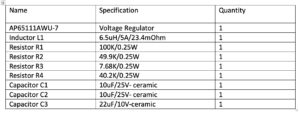
The wiring diagram

Circuit diagram of the DC-DC power supply.
Technical insights
The switch-mode buck IC
The AP65111A is an adjustable buck converter that provides 5Vs of regulated power at the output. The IC’s input voltage range is 4.5 to 18V. Its output has a continuous current of 1.5A.
Features
1. Overvoltage protection. When the FB pin exceeds 115% of the nominal voltage of 0.8V, the regulator will stop switching and the voltage will drop by discharging through the capacitor.
2. Overcurrent protection. When the inductor peak current exceeds its current limit, it triggers the current protection. When the FB pin voltage drops below 0.4V, the device enters the hiccup mode and periodically restarts the parts. This will reduce the IC’s thermal stress.
3. Automated no load/light load. In case of a light load or no load, the IC enters into a low-load, high-efficiency mode. Once it detects a high load, it will automatically enter into a pulse-width modulation mode for high efficiency.
4. Thermal protection. When the junction temperature of the IC exceeds 160° C, the IC will turn off. Once it cools to 120° C, the IC enables a soft start.
5. Soft start. The IC has an internal soft start period of 1ms.

Pin diagram AP65111A
Major pin’s description
EN – a digital pin that turns the IC ON and OFF. Drive EN high to turn it ON, and low to OFF it. For an automatic startup, pull it with 100k resistors.
FB – senses the output voltage and regulates it. Connect it to a resistive divider network for setting the output voltage.
The circuit design
The circuit design includes the energy storage element. An inductor stores energy in the form of a magnetic field. The inductor for this project acts as an energy-storing element.
The equation for calculating the inductor’s value for the buck converter:
L = Vout(Vin-Vout)/(Vin.dIL.Fsw)
dIL = Inductor ripple current
Fsw = Switching frequency of the regulator
The inductor ripple current should be 30 to 40% of the maximum load current. The inductor peak current will be:
IL = Iload + dIL/2
The peak current “decides” the saturation current rating of the inductor. Saturating the inductor will decrease the efficiency of the converter. For this application, it’s possible to choose an inductor between 1 to 10uH.
So, let’s use an inductor of 6.5uH and calculate the maximum current rating of the inductor:
L = Vout(Vin-Vout)/(Vin.dIL.Fsw)
Fsw = 500kHz
6.5u = 5(12-5)/(12*dIL*500k)
dIL = 0.89A
IL = Iload + dIL/2
Iload = 1.5A
IL = 1.95A
We can then analyze the above calculation. Take the minimum inductor current rating of 25 to 30% above the maximum load current. We should also take the DC resistance of the inductor with less than 20m ohms to ensure high efficiency.
The filtering element
Input: the input capacitor helps reduce the surge current during the ON state of the device. The RMS current rating of the input capacitor should be greater than half of the maximum load current. The ESR of the capacitor should be low because of the high change of current rate (dI/dt) via the input capacitor. For this design, a 22uF capacitor works fine.
Output: the output capacitor reduces the output voltage spikes, maintains the loop stability, and reduces the overshoot of the output voltage. It helps in fast transient response and provides the current for a few cycles during load transients. An output capacitor with a high value and low ESR is ideal. In this application, we can use a 22uF ceramic capacitor for the output.
We can calculate the capacitor value with this equation:
Co = L(Io + dIL/2)2/(dV + Vo)2 – Vo2
Feedback network
Now for the output voltage setting. As per the wiring diagram, the resistance R4 and R3 decide the output voltage.
Here’s the equation:
Output voltage, Vout = 0.8(1+R4/R3)
R4 = 40.2K, R3 = 7.68K
Vout = 5V approx.
The resistance R2 is also recommended for improving system stability, particularly for the Vout < 3.3V.
Thermal management
To uncover the maximum power that the regulator IC can dissipate, use this equation:
Pd(max) = (TJ – TA)/ QJA
Where,
QJA and TJ are motioned in the data sheets of the IC
TJ = maximum junction temperature = 160°
QJA = thermal resistance (Junction to Ambient) = 120° C/W
TA, = ambient temperature = 30° (as per the environmental condition)
Pd(max) = maximum power dissipation of the device
By putting all the value in above equation, we get:
Pd(max) = 1.08W
This is the maximum power that the IC can dissipate without a heatsink — but only in natural airflow conditions.
As the power dissipation increases, it becomes necessary to mount a heatsink or cooling fan to dissipate the excess heat, otherwise the regulator will malfunction.
Practical observation
Vin, Input voltage = 12V
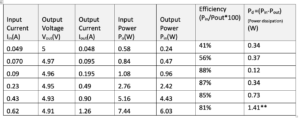
**For a current of 1.26A the power dissipation is 1.41W. As this exceeds the maximum power dissipation limit of the IC, we’ll need to mount a heatsink to dissipate the extra heat.
Note: To learn more about how to select a heatsink, refer to this article.

The load regulation curve between the output voltage compared to the output current.
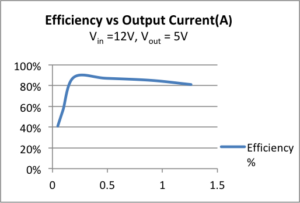
The observed results.

The data-sheet characteristics.
IC performance
5. Under light load (<100mA), the efficiency is low and below 50%
6. At higher loads, the IC performs as expected, with an average efficiency of 85%
7. Load regulation: Regulated 5V for current < 50mA
Precautions
- A capacitor should be connected between the IN pin and the ground to regulate the DC input voltage.
- The circuit’s capacitor must have a higher voltage rating than the input supply voltage. Otherwise, the capacitor starts leaking current because of the excess voltage at its plates, and it will burst out.
- Ensure the capacitor is fully discharged before working on a DC power supply.
- The current rating of the inductor should be 1.15 times greater than the output current.
- Never give a higher voltage at input than the IC operating input voltage range.
- Avoid shorting the output terminals — this will reverse the current flow in the IC, leading to faults.
- Also, do not short the input terminals — this will generate a large current in the circuit, and the components in the circuit will get faulty.
- Consider the frequency effect.
PCB design guidelines
- Keep the power traces thick and short
- Place the input and output capacitor as close as the IC’s input and output pins
- Minimize the path length of the inductor
- Keep the voltage and switching nodes away from each other
- Keep all components as close as the IC and try to reduce the size of the PCB
- Remember: the higher the frequency of the IC, the higher the switching losses, which decreases the efficiency. But a high-switching frequency reduces the size of the energy storage element and improves the transient response.

The PCB design layout.

A PCB animated 3D view.

The real-time image.
You may also like:
Filed Under: Tutorials

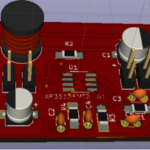
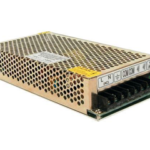



Questions related to this article?
👉Ask and discuss on Electro-Tech-Online.com and EDAboard.com forums.
Tell Us What You Think!!
You must be logged in to post a comment.